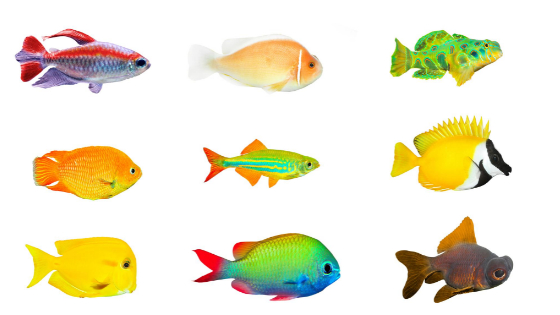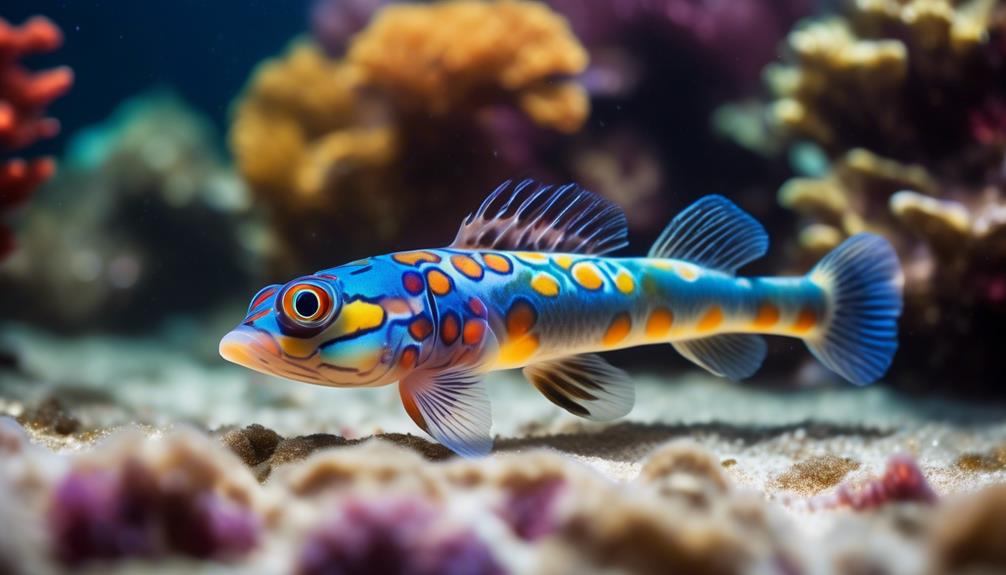
Are colorful saltwater gobies truly as hardy as they are dazzling? This question lingers in the minds of aquarium enthusiasts who seek to add a touch of vibrancy to their underwater worlds.
With their striking appearance and wide distribution, these small tropical fish have captured the attention of hobbyists worldwide. From their vibrant hues to their peaceful temperament, gobies possess a charm that is difficult to resist.
But what lies beneath their colorful exteriors? In this article, we will explore the captivating world of saltwater gobies, delving into their maintenance, care, and feeding requirements, and uncovering the secrets that make them both dazzling and hardy.
Key Takeaways
- Saltwater gobies are small, torpedo-shaped fish with vibrant colors and a unique disc-shaped sucker formed by their fused pelvic fins.
- They can change their coloration to blend in with their surroundings, providing camouflage from predators.
- Saltwater gobies are hardy and adaptable to a range of aquarium conditions.
- They have specific adaptations that allow them to thrive in their marine habitats, including specialized gills and the ability to tolerate a wide range of salinity levels.
Size and Appearance
Saltwater gobies are small, torpedo-shaped fish with vibrant colors and a unique disc-shaped sucker formed by their fused pelvic fins. These fascinating creatures typically measure only a couple of inches in length, making them perfect for smaller aquariums.
Their torpedo-shaped bodies allow them to swiftly navigate through the water with ease. One of the most striking features of saltwater gobies is their dazzling coloration. They come in a wide range of shades, including red, yellow, orange, blue, green, silver, white, brown, grey, and black. This makes them one of the most colorful species of saltwater fish.
With their small size and vibrant appearance, saltwater gobies add a splash of beauty to any aquarium.
Origins and Distribution
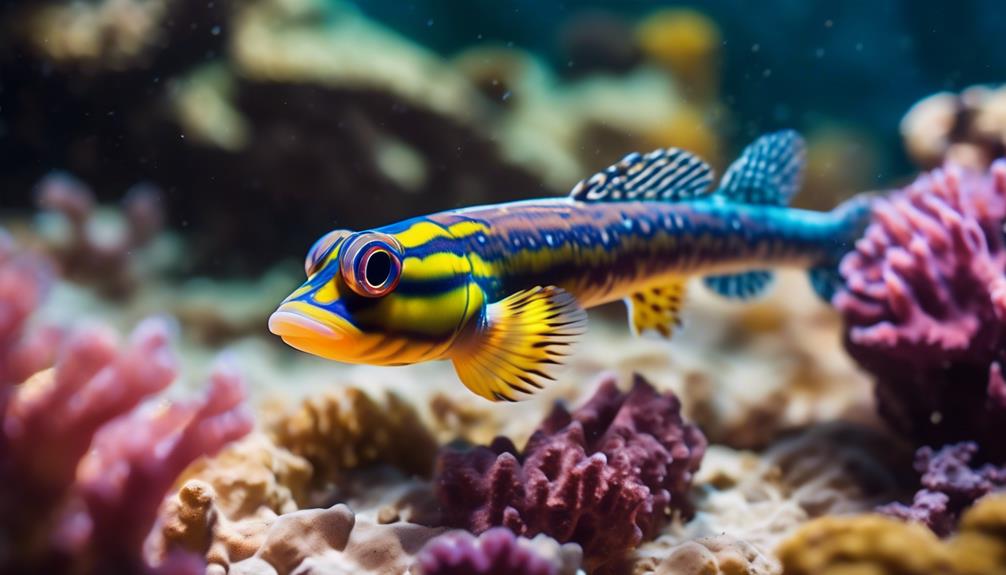
These vibrant and captivating fish are found in the shallow tropics of oceans worldwide.
With a wide distribution across the globe, the saltwater goby can be found in various tropical regions, from the Pacific and Indian Oceans to the Caribbean Sea. They thrive in warm waters with temperatures ranging from 72 to 82 degrees Fahrenheit.
These gobies have adapted to different habitats, including coral reefs, seagrass beds, mangroves, and rocky shores. Their ability to inhabit such diverse environments is a testament to their hardiness and adaptability.
Whether it’s the crystal-clear waters of the Maldives or the vibrant coral reefs of the Great Barrier Reef, the saltwater goby adds a splash of color to any tropical ecosystem it calls home.
Coloration
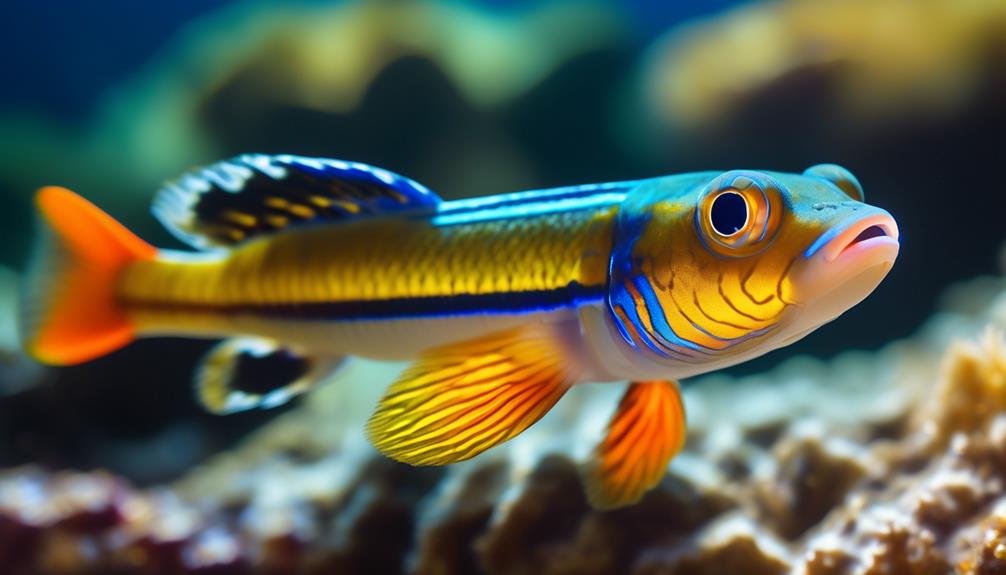
With their vibrant shades of red, yellow, orange, blue, and more, the saltwater goby stands out as one of the most colorful species of fish in the ocean. These dazzling colors are a result of pigments within their skin cells called chromatophores.
The saltwater goby has an incredible array of colors, including green, silver, white, brown, grey, and even black. The purpose of their colorful appearance is multifaceted. It can be used for communication, attracting mates, or even as a defense mechanism.
Some gobies have the ability to change their coloration to blend in with their surroundings, providing camouflage from predators. Others use their vibrant colors to signal aggression or dominance.
Regardless of the reason, the saltwater goby’s coloration is truly a sight to behold in the underwater world.
Maintenance and Care
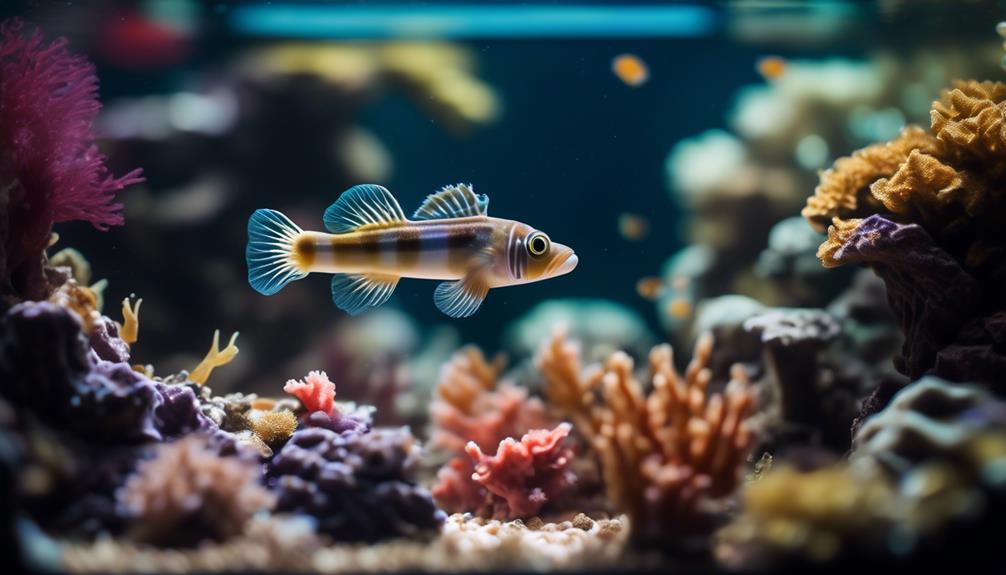
To properly care for a saltwater goby, it’s important to provide a suitable environment and meet their specific needs. These gobies are hardy and adaptable to a range of aquarium conditions. They’ve a peaceful temperament, but can be aggressive towards other gobies, so it’s best to keep them with peaceful tank mates.
Additionally, they require numerous caves and crevices in their tank as they’re intelligent and remember specific landmarks. It’s also important to note that saltwater gobies burrow in soft sand substrate and should be kept in tanks with tight-fitting lids.
When it comes to feeding, they’re primarily carnivores and their diet should consist of live or frozen foods like brine shrimp, mysis shrimp, krill, and plankton.
Feeding
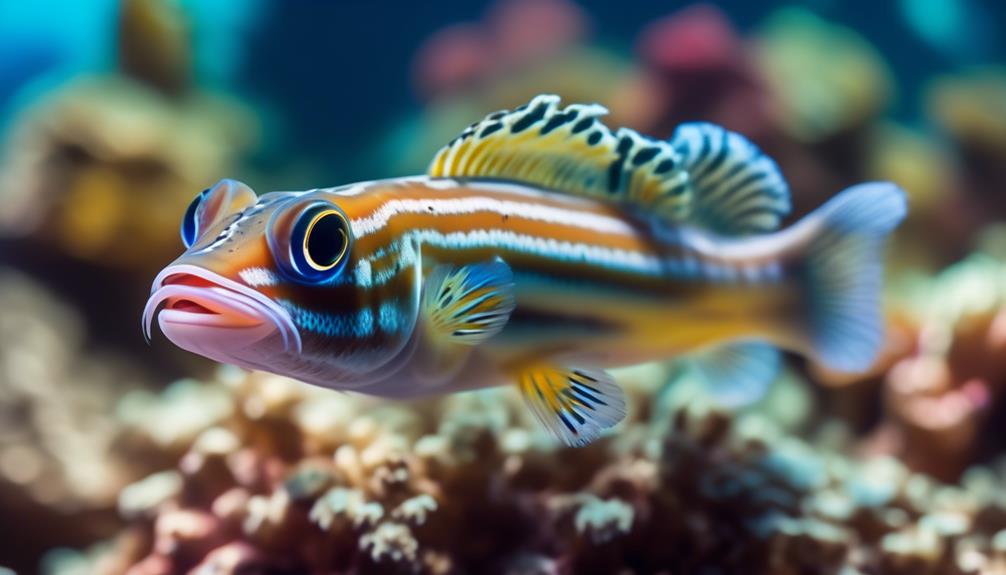
How do saltwater gobies meet their dietary needs?
Saltwater gobies are primarily carnivores and have specific dietary requirements to meet their nutritional needs. Here are three key aspects of their feeding habits:
- Live and Frozen Foods: Saltwater gobies thrive on a diet consisting of live or frozen foods. Popular food options include brine shrimp, mysis shrimp, krill, and plankton. These foods provide the necessary proteins and nutrients for their growth and overall health.
- Small Prey: Due to their small size, saltwater gobies prefer to feed on small prey. They’ve adapted to catching and consuming tiny organisms such as copepods, amphipods, and small crustaceans. These small prey items are easily digestible and fulfill their dietary requirements.
- Opportunistic Feeders: Saltwater gobies are opportunistic feeders, meaning they’ll eat whatever food source is available to them. In the wild, they scavenge for food in coral reefs, feeding on small invertebrates and algae. In an aquarium setting, they readily accept a variety of foods, making them relatively easy to feed.
Tank Setup
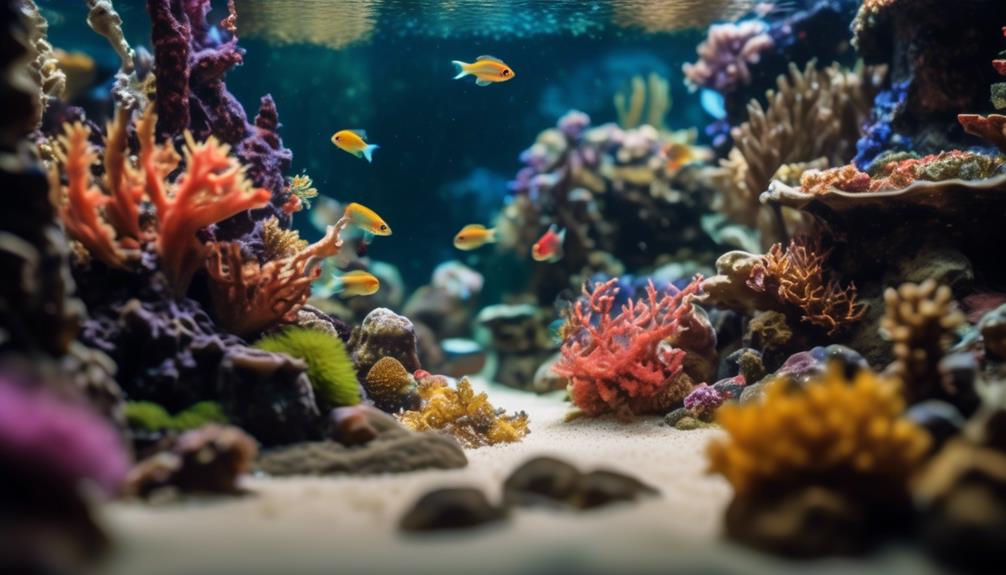
After addressing the dietary needs of saltwater gobies, the next important aspect to consider is setting up their tank.
Saltwater gobies are hardy and adaptable, but they still require specific conditions to thrive. It’s recommended to provide them with a peaceful environment and numerous caves and crevices where they can hide and explore. Gobies are intelligent and can remember specific landmarks in the aquarium, so it’s important to create a visually stimulating tank with various decorations.
They prefer a soft sand substrate where they can burrow. Additionally, it’s crucial to have a tight-fitting lid on the tank, as gobies are known to jump.
Breeding and Reproduction
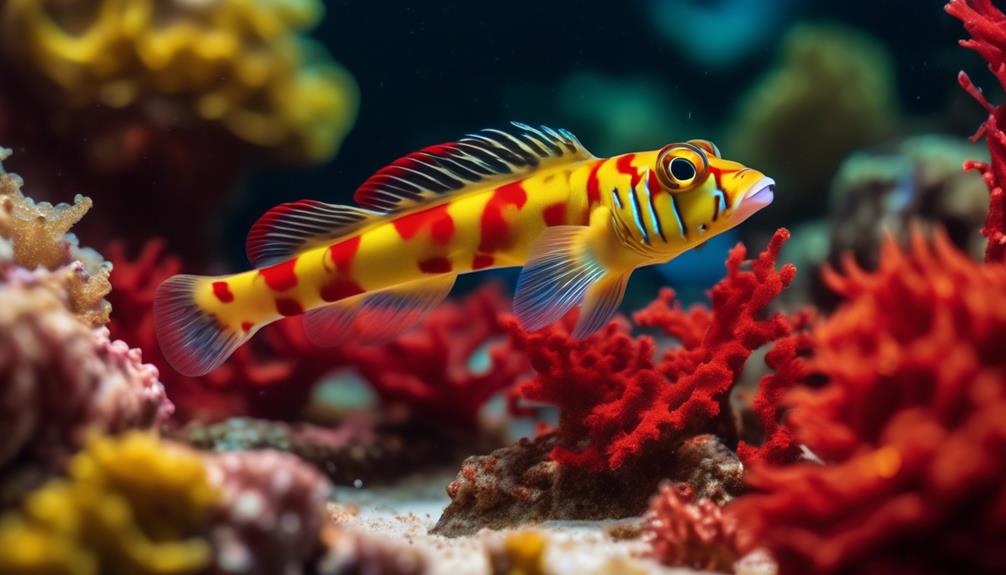
Breeding and reproduction in saltwater gobies involve intricate courtship rituals and the laying of adhesive eggs. Here are three key aspects of their breeding behavior:
- Courtship rituals: Saltwater gobies engage in complex courtship displays to attract a mate. These displays often include vibrant color changes, fin flaring, and intricate swimming patterns. Males may also build nests or clear spawning sites to entice females.
- Egg laying: Once courtship is successful, the female will lay adhesive eggs on a substrate, such as rocks, coral, or plants. The male may guard the eggs, fanning them to provide oxygen and protect them from predators. The adhesive nature of the eggs ensures they stay in place until they hatch.
- Parental care: Some saltwater gobies exhibit parental care, with both male and female sharing the responsibility of guarding and caring for the eggs and fry. They may also engage in mouthbrooding, where one parent carries the eggs or fry in their mouth until they’re ready to be released.
Understanding the breeding and reproductive behaviors of saltwater gobies is essential for successfully breeding them in captivity and preserving their vibrant colors and hardy nature.
Common Species of Saltwater Gobies
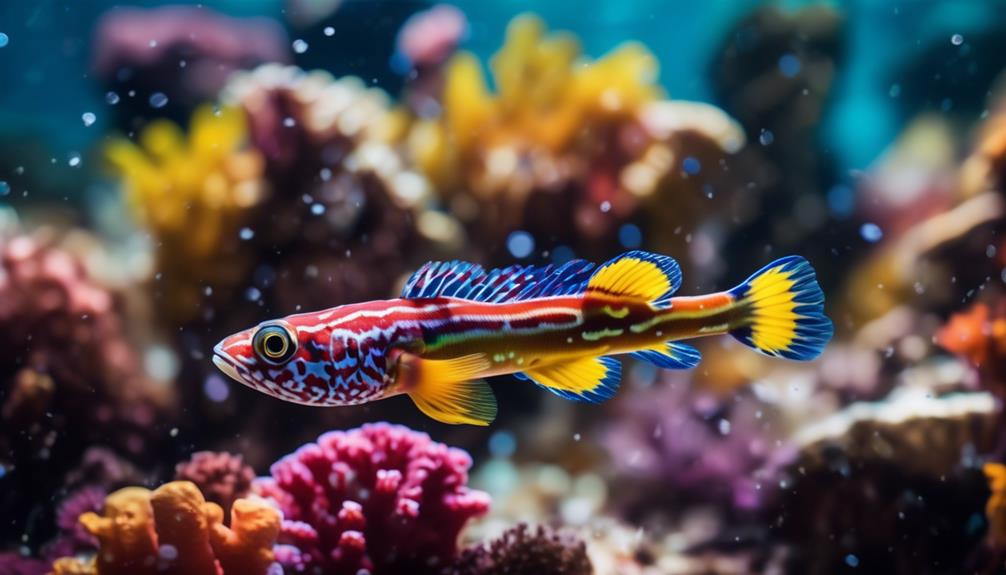
The common species of saltwater gobies display a wide range of vibrant colors and unique characteristics.
One well-known species is the Neon Goby (Elacatinus oceanops), which features a bright blue body with a yellow stripe running down its side.
Another popular species is the Clown Goby (Gobiodon spp.), which boasts a striking combination of yellow, green, and blue colors.
The Firefish Goby (Nemateleotris magnifica) is also highly sought after, with its stunning red and purple hues.
Additionally, the Yellow Watchman Goby (Cryptocentrus cinctus) stands out with its yellow body and black markings.
These common saltwater gobies not only add a splash of color to aquariums but also bring a sense of liveliness and beauty to any marine environment.
Interesting Facts About Saltwater Gobies
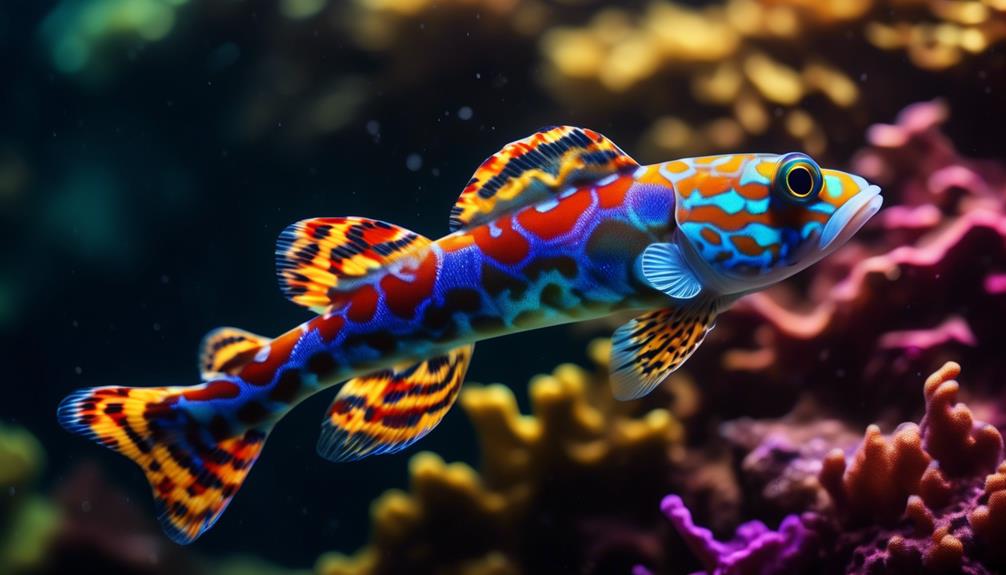
One fascinating aspect about saltwater gobies is their ability to camouflage themselves in their surroundings. This unique adaptation allows them to blend in with their environment, making it difficult for predators to spot them.
Here are three interesting facts about saltwater gobies:
- Mimicry: Some species of saltwater gobies have the ability to mimic other fish or invertebrates in order to confuse predators. They can change their coloration and body shape to resemble toxic or venomous species, deterring potential threats.
- Cleaning symbiosis: Many saltwater gobies have a mutually beneficial relationship with other marine species, such as cleaner shrimp or cleaner wrasses. They allow these cleaner organisms to remove parasites and dead skin from their bodies, while also benefiting from the cleaning service.
- Jumping ability: Despite their small size, saltwater gobies are known for their impressive jumping abilities. They can leap out of the water to catch flying insects or to escape from predators. This behavior is especially common in species that inhabit tidal pools or areas with low water levels.
These facts highlight the remarkable adaptations and behaviors of saltwater gobies, making them even more intriguing to observe in their natural habitats.
Frequently Asked Questions
Are Saltwater Gobies Suitable for Beginners in the Aquarium Hobby?
Saltwater gobies can be suitable for beginners in the aquarium hobby. They are hardy and adaptable to different tank conditions. However, they can be aggressive towards other gobies, so careful consideration should be taken when choosing tank mates.
Can Saltwater Gobies Be Kept in a Reef Tank With Corals and Other Invertebrates?
Yes, saltwater gobies can be kept in a reef tank with corals and other invertebrates. They are peaceful and won’t harm the corals. However, it’s important to choose gobies that are reef-safe and won’t disturb the delicate balance of the tank.
Do Saltwater Gobies Require Specialized Lighting in Their Aquarium?
Saltwater gobies do not require specialized lighting in their aquarium. They thrive under standard aquarium lighting conditions. However, it is important to provide them with plenty of caves and crevices for hiding and burrowing.
How Often Should Saltwater Gobies Be Fed and What Is the Recommended Portion Size?
Saltwater gobies should be fed daily with small portions that they can consume within a few minutes. It is recommended to provide a varied diet of live or frozen foods such as brine shrimp, mysis shrimp, krill, and plankton.
Are There Any Specific Water Parameters That Need to Be Maintained for Saltwater Gobies?
Specific water parameters need to be maintained for saltwater gobies. These hardy fish thrive in water with a temperature range of 72-78°F, pH level of 8.1-8.4, and salinity of 1.022-1.025. Regular monitoring and adjustments are necessary for their well-being.
What Makes Saltwater Gobies Colorful and Hardy Compared to Freshwater Fish?
Saltwater gobies are known for being more colorful and hardy compared to their freshwater counterparts. Their vibrant hues and resilience have made them a popular choice for aquarium enthusiasts. Through careful observation and discovery, researchers have found that these colorful freshwater fish possess unique adaptations that allow them to thrive in their marine environments.
Conclusion
In conclusion, the colorful saltwater gobies are a captivating addition to any aquarium. With their vibrant hues and peaceful temperament, they bring a touch of vibrancy to underwater worlds.
These hardy fish are highly adaptable and require a well-maintained tank with plenty of caves and crevices to explore. By providing the proper care and feeding, aquarium enthusiasts can enjoy the beauty and intelligence of these small but remarkable creatures.




